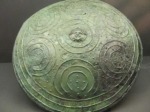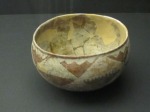From November 20 until January 6, the exhibition “Treasures of Albanian Cultural Heritage” will be at the Vittoriano Museum Complex in Rome, and from January 23 to April 7, 2013 at Palazzo Madama in Torino*.
One hundred and fifty exhibits* *, artifacts and works from prehistoric times to the seventeenth century will be on display in a free exhibition that is sponsored by the President of the Italian Republic, in cooperation with Albania’s Ministry of Foreign Affairs and Ministry of Culture, The Embassy of Albania in Italy, the Lazio Department of Culture and the city of Torino. The exhibition is curated by Apollon Bace of the Tirana Centre of Monuments of Culture in collaboration with Shpresa Gjongecaj of Albania’s Institute of Archaeology and Neritan Ceka, archaeologist and adviser to the Prime Minister for Culture and Heritage (now Ambassador to Italy), and coordinated by the Director of the Vittoriano Museum, Alessandro Nicosia. The exhibition was inaugurated by many senior ranking bureaucrats as well as academics and scholars, under the framework of 100 years of Albanian Independence.

It is a made up of items from museums throughout Albania, including Berat, Tirana, Durres and Apollonia. It covers various daily-use objects from the Neolithic period (beginning sixth millennium BC), bronze weapons and gold jewelry, figures in terracotta from the Archaic Age (VII – VI century BC), a terracotta of Aphrodite and the marble and stone of the Hellenic period, (V century BC), coins from the Roman administration(II century BC), onward to the High Middle Ages, and wooden icons of late antiquity (XVI century), showing the continuous exchanges with Italy and the East.


Illyrian shield from Apollonia Museum


Icon from Onufri Museum, Berat
On display is the 4th century BC head of Apollo, as well as finds from the Hellenic and Roman periods, icons painted by Onufri, and the Epitaph of Gllavenica with the Deposition of Christ embroidered in silk, silver and copper. Also a ”triple vessel” made of pottery from the eighth century BC, a 12th century BC “jewel of gold spiral” and 4th century BC silver bracelet. There are terracottas depicting Aphrodite and Apollonia, and a marble head of Apollo from the first half of the fourth century BC. Among the icons is a tempera on wood of the Church of the Annunciation of Berat dated to the mid 16th century

Epitaph of Gllavenica, National History Museum, Tirana
The exhibition also highlights the archaeological cooperation between Albanians and Italians and contains some of the discoveries made by Luigi Maria Ugolini*, the Italian archaeologist who helped uncover Butrint.
During the exhibit’s month and a half in Rome where admission was free, it attracted 45,000 visitors. It is currently on display in Torino until April 7, with admission of 10 euros.


No comments:
Post a Comment